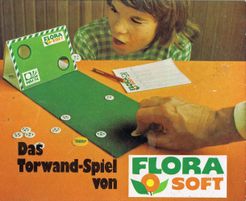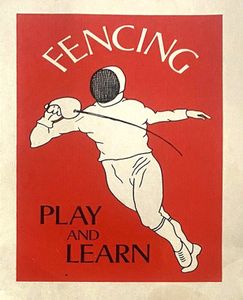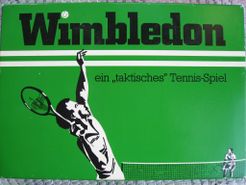|
Advertisement
|
Maillot Jaune

DescriptionMaillot Jaune (Yellow Jersey) is a hard to find hand-made cycling simulation by the Swiss Patrick Inauen that developed with support from his brother Adrian. Its main purpose is to recreate the Tour de France in its entirety over 14 stage sessions, with each player in charge of a team of 8 riders with individual abilities. But what you get, in essence, is a highly flexible modular stage construction kit that allows you to create a wide range of possible races for 6 teams of 8 riders each, using 136 plain-colored terrain tiles in 5 colors. And although its scope is for an entire Tour, it is equally feasible to play only a single stage, recreate other tours and existing one-day classics, or embark on a completely made-up race. Saying that, a lot of the dynamics only come into play when team managers aren't only trying to snatch the stage victory from their competitors, but need to keep an eye on the overall rankings for each individual rider as well, as the end goal is to carry the Yellow Jersey to Paris. More so, and just like in the real Tour, the Sprint and Mountain Tricots are also up for grabs, so during each race it is important to get your key riders in point-scoring positions at the right time. This dice-driven racing simulation includes rules for terrain handling, breakaways, tempo raising, slipstreaming, pack-splitting, sprints, fatigue, doping-use, overtaking, falls, team-cooperation and other events, but squeezes all this in a simple system that does not bogs down in details or oodles of bookkeeping. By stripping the inner workings of a cycling race down to core mechanics that are based around only 4 different types of terrain tile (flat, uphill, downhill, and - to settle communal arrivals - sprints), the game instead concentrates on the different abilities of each rider to use certain types of terrain to his advantage. These abilities, again, are stripped down to their core. Team sheets show 8 unique riders, each with 4 to 8 special action points in specific terrain colours, that get covered when used. Remarkably, this is enough creates a race dynamic that is genuinely similar to the real deal. Servants will be used to get the specialists in position, or bridge gaps to escaped groups or soloists. The stronger riders will use their abilities to snatch points on their favourite type of terrain, and the team champions will be protected by their team members for most of the race, but ultimately need to rely on their superior movement bonuses to battle it out amongst each other. Often, the mountain stages are key arenas that shape the face of the remaining Tour, when riders no longer can rely on group efforts, and have to face the long uphill climb on individual strength alone. Each stage, team leaders will need to balance the need for interteam co-operation against their individual team's chances to gain an advantage. Sounds familiar? During the race, the starting pack will slowly split up in individual packs, smaller groups (2-7 riders) and soloists, all standing on their own terrain tiles in small stacks of numbered plastic pieces in the 6 team colors (for larger packs replacement markers are used). In a standard turn, the top cyclist on each tile-stack will throw the D20, and move 1 forwards on an odd roll, and 2 tiles on an even, taking the entire underlying stack along through slipstreaming. That cyclist will then have spent his energy and move to the bottom of the stack, handing over the front position to the next one in line. From the head of the race down, each tile with riders will be dealt with in turn, and that process repeats itself until all riders have completed the stage, or are disqualified for arriving too late, with a bigger time-gap to the leader than allowed. Each standard (group) move can be modified by one special move if managers so desire, and if they have the rider(s) that can pull it off on that type of terrain. This special move can either be a breakaway attempt, a general raising of the tempo, a deliberately go-slow decision by the speed-setting rider, or a tactical manoeuvre that can cause a pack to split. Each time a rider uses a speciality point, it is marked off from his entry on the team sheet. When the last ability point has been covered up, that rider is too tired to pull off any further special moves. A rider that has spent all his bonus points will start the next stage fatigued, whereas a rider that has spared himself will enter the next stage with a bonus point, just like the new holder of the Yellow Jersey. When the race leader changes terrain type, a random event is triggered that can befall any rider in the race. When more than 1 rider arrives at a sprint banner, the top of a mountain, or the finish line, a sprint is triggered to settle the differences. Riders who can draw on team support, or are natural sprinters can use this to start the sprint in advantageous positions. This is a great game for fans of the cycling genre, but might be a tad repetitive for others, especially when a lot of team managers join the race and when the starting pack splits up in many different groups. It then takes quite a few die rolls before the 50 to 90 tile route has been conquered by all. As a sport simulation, it works best when a full field of riders is present, and when an entire tour is played out over multiple sessions. If you play individual stages only, the race dynamics are far less colourful since the team managers only need to focus on getting one rider through the finish line, rather than juggle positions, general fitness, and overall rankings of their entire team of riders. Included with the set are the assembly instructions for the 14 stages, and team sheets for each team manager, detailing the individual abilities of 8 unique (real-life) riders from the 1995 tour. It isn't clear if the brothers intended to supply updated packs for subsequent tours and races, but enthusiasts have. PUBLICATION HISTORY:Maillot Jaune was Patrick's debut game, and was launched at the Schweizer Spielmesse in 1995, where it sold all of 13 stickered white cardboard boxes. It re-appeared one year later in another limited hand-made production as "Le Tour". The lovingly assembled sets consist of plain colored tiles, generic plastic pieces, sticker sheets, and well-presented photocopied rules and team sheets. Both productions are long gone and very hard to trace down. ADDITIONAL INFO:
Game DiscussionsAdd CommentYou need to be logged in to comment. Insert Bullet List Please enter at least one item. Item: Item: Item: Item: Item: Insert Numeric List Please enter at least one item. Item: Item: Item: Item: Item: Insert Link Please enter the link of the website Optionally you can add display text Insert Email Please enter the email address Optionally add any display text Insert Image Please enter the link of the image Insert YouTube Video Please enter the link of the video MarketplaceNo listings at the moment. Do you own this game? Click here to list it for sale.
|
Best Sellers
Board Games
|
||||
Latest Searches: monopley | mochi koro | slidell opoly | Hammondopioly | Aliens | transfomers studio series | ghost stories | Alan Smithee | Luisa | Rowan university | monopoly ga. | Wilkesboro o poly | paste | Mountain climb | cle | vermilion parish monopoly | flip city | MN Vikings monopoly | C | are you dumber than | Discovering Europe | name of the rose | Coap | brake | vampire | Blink | lord+of+the | nurf laser ops pro | Clever+hoch+drei | isle+of+cats
All Rights Reserved











Comments (0)